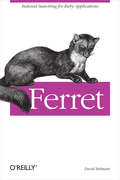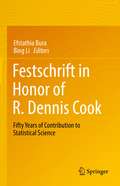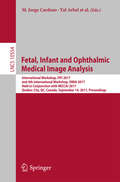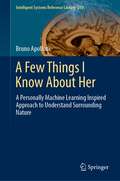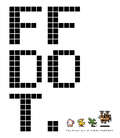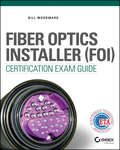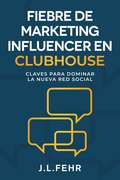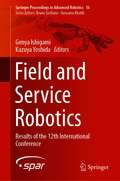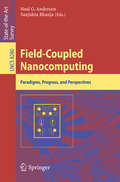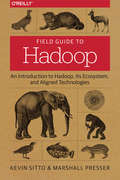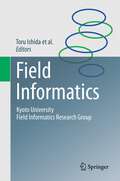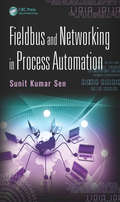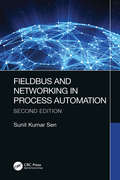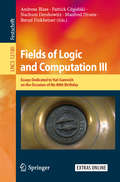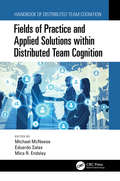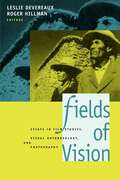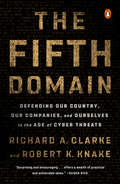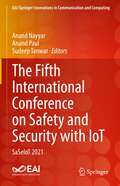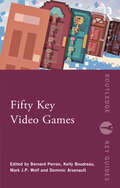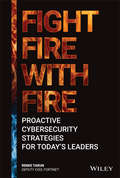- Table View
- List View
Ferret
by David BalmainWith the introduction of Ferret, Ruby users now have one of the fastest and most flexible search libraries available. And it's surprisingly easy to use. This book will show you how to quickly get up and running with Ferret. You'll learn how to index different document types such as PDF, Microsoft Word, and HTML, as well as how to deal with foreign languages and different character encodings. Ferret describes the Ferret Query Language in detail along with the object-oriented approach to building queries. You will also be introduced to sorting, filtering, and highlighting your search results, with an explanation of exactly how you need to set up your index to perform these tasks. You will also learn how to optimize a Ferret index for lightning fast indexing and split-second query results.
Festschrift in Honor of R. Dennis Cook: Fifty Years of Contribution to Statistical Science
by Efstathia Bura Bing LiIn honor of professor and renowned statistician R. Dennis Cook, this festschrift explores his influential contributions to an array of statistical disciplines ranging from experimental design and population genetics, to statistical diagnostics and all areas of regression-related inference and analysis. Since the early 1990s, Prof. Cook has led the development of dimension reduction methodology in three distinct but related regression contexts: envelopes, sufficient dimension reduction (SDR), and regression graphics. In particular, he has made fundamental and pioneering contributions to SDR, inventing or co-inventing many popular dimension reduction methods, such as sliced average variance estimation, the minimum discrepancy approach, model-free variable selection, and sufficient dimension reduction subspaces.A prolific researcher and mentor, Prof. Cook is known for his ability to identify research problems in statistics that are both challenging and important, as well as his deep appreciation for the applied side of statistics. This collection of Prof. Cook's collaborators, colleagues, friends, and former students reflects the broad array of his contributions to the research and instructional arenas of statistics.
Fetal, Infant and Ophthalmic Medical Image Analysis: International Workshop, FIFI 2017, and 4th International Workshop, OMIA 2017, Held in Conjunction with MICCAI 2017, Québec City, QC, Canada, September 14, Proceedings (Lecture Notes in Computer Science #10554)
by M. Jorge Cardoso, Tal Arbel, Andrew Melbourne, Hrvoje Bogunovic, Pim Moeskops, Xinjian Chen, Ernst Schwartz, Mona Garvin, Emma Robinson, Emanuele Trucco, Michael Ebner, Yanwu Xu, Antonios Makropoulos, Adrien Desjardin and Tom VercauterenThis book constitutes the refereed joint proceedings of the International Workshop on Fetal and Infant Image Analysis, FIFI 2017, and the 6th International Workshop on Ophthalmic Medical Image Analysis, OMIA 2017, held in conjunction with the 20th International Conference on Medical Imaging and Computer-Assisted Intervention, MICCAI 2017, in Québec City, QC, Canada, in September 2017. The 8 full papers presented at FIFI 2017 and the 20 full papers presented at OMIA 2017 were carefully reviewed and selected. The FIFI papers feature research on advanced image analysis approaches focused on the analysis of growth and development in the fetal, infant and paediatric period. The OMIA papers cover various topics in the field of ophthalmic image analysis.
A Few Things I Know About Her: A Personally Machine Learning Inspired Approach to Understand Surrounding Nature (Intelligent Systems Reference Library #219)
by Bruno ApolloniThis book reconsiders key issues, such as description and explanation, which affect data analytics. For starters: the soul does not exist. Once released from this cumbersome roommate, we are left with complex biological systems: namely, ourselves, who must configure their environment in terms of worlds that are compatible with what they sense. Far from supplying yet another cosmogony, the book provides the cultivated reader with computational tools for describing and understanding data arising from his surroundings, such as climate parameters or stock market trends, even the win/defeat story of his son football team. Besides the superposition of the very many universes considered by quantum mechanics, we aim to manage families of worlds that may have generated those data through the key feature of their compatibility. Starting from a sharp engineering of ourselves in term of pairs consisting of genome plus a neuron ensemble, we toss this feature in different cognitive frameworks within a span of exploitations ranging from probability distributions to the latest implementations of machine learning. From the perspective of human society as an ensemble of the above pairs, the book also provides scientific tools for analyzing the benefits and drawbacks of the modern paradigm of the world as a service.
FF DOT: The Pixel Art of Final Fantasy
by Square EnixA hardcover volume that showcases the intriguing evolution of pixel art from the Final Fantasy series!Containing detailed sprite sheets that showcase the pixel composition of Final Fantasy's beloved characters, maps of Final Fantasy's most popular highlighting tools used by the developers, and a special interview with Kazuko Shibuya, the character pixel artist for the Final Fantasy series, FF Dot is a one of a kind product that immerses readers into an iconic aspect of the Final Fantasy experience. Dark Horse Books is proud to collaborate with Square Enix to bring fans FF Dot: The Pixel Art of Final Fantasy, translated into English for the first time. This localization of the original Japanese publication holds nearly 300 pages of colorful pixel art, and is an invaluable addition to any Final Fantasy fan's collection.
Fiber Optics Installer (FOI) Certification Exam Guide
by Bill WoodwardPass the FOI exam with a strong foundation in fiber optic technologyFiber Optics Installer (FOI) Certification Exam Guide gives you a solid foundation in fiber optics and thorough preparation for the Fiber Optics Installer (FOI) certification. Endorsed by the Electronics Technicians Association, International, this guide serves as both a comprehensive self-study course and a useful desk reference for aspiring fiber optics installers. Coverage includes the basic principles of light, optical fiber construction, safety, fusion, mechanical splicing, connectors, fiber-optic light sources, transmitters, detectors, test equipment, and more. Each chapter meets or exceeds the ETA FOI knowledge competency, with key exam information highlighted for easy reference. Real-world scenarios illustrate how particular solutions are applied in common working environments, giving you a clear understanding of to use the tactics in the field. Chapter exercises and review questions offer plenty of opportunity for practice.This book helps you prepare for certification, and more importantly, the everyday work the job entails.Determine how much you already know with a pre-study assessmentFind key exam information and terms quickly with chapter-by-chapter objectivesStudy real-world scenarios to understand how concepts are appliedPinpoint weak areas with practice and review questions that test your knowledgeIf you are seeking a strong knowledge base -- and complete exam prep -- you will find Fiber Optics Installer (FOI) Certification Exam Guide to be a critically useful reference.
Fibrous materials
by Krishan K. ChawlaThis new updated edition provides an unrivaled overview of fibrous materials, their processing, microstructure, properties, and applications. The entire range of fibrous materials is discussed in depth, from natural polymeric fibers such as silk and vegetable fibers, and synthetic polymeric fibers such as aramid and polyethylene, to metallic fibers including steel, tungsten, Nb-Ti, and Nb3Sn, ceramic fibers such as alumina and silicon carbide, and carbon and glass fibers. Fundamental concepts are explained clearly and concisely along with detail on applications in areas including medicine, aerospace, optical communications, and recycling. Significant recent advances are also covered, with new information on the electrospinning of fibers, carbon nanotubes, and photonic bandgap fibers, and detail on advances made in the production and control of microstructure in high stiffness and high strength fibers. Accessibly written and unrivaled in scope, this is an ideal resource for students and researchers in materials science, physics, chemistry, and engineering. The only comprehensive introduction to the topic. Fully updated with new information on electrospun fibers, carbon nanotubes, and photonic bandgap fibers. Covers a range of applications in areas including medicine, aerospace, optical communications, and recycling.
Fiebre De Marketing Influencer en Clubhouse: Claves Para Dominar La Nueva Red Social
by J. L. FehrLos influencers no son los únicos que están promocionándose en Clubhouse, la red social de audio. Y pese a su popularidad, muchos ni siquiera han oído de ella. Así que, ¿por qué deberías estar allí, y cuál es la mejor forma de aprovecharla? El espacio entre nuestras orejas es uno de los sitios más íntimos que podemos concederle a otras personas, y las voces pueden transmitir una vida entera de experiencias en un instante. El volumen, el registro, el tono, la dicción, y las palabras mismas; todos éstos elementos dejan impresiones indelebles. Clubhouse da lugar a las interacciones entre personas más profundas, cuando se la compara con el resto de las redes sociales. Y aún así, es preciso aprender a usar correctamente la app para convertirla en una poderosa y nóvel herramienta de comunicación. Este libro se escribió para ayudarte a aprender cómo usar esta plataforma, para que puedas promocionarte de la misma forma que lo hacen los influencers más notables.
Field and Service Robotics: Results of the 12th International Conference (Springer Proceedings in Advanced Robotics #16)
by Genya Ishigami Kazuya YoshidaThis book comprises select proceedings of the 12th Conference on Field and Service Robotics (FSR 2019) focusing on cutting-edge research carried out in different applications of robotics, including agriculture, search and rescue, aerial marine, industrial, and space. It focuses on experiments and demonstrations of robotics applied to complex and dynamic environments and covers diverse applications. The essays are written by leading international experts, making it a valuable resource for researchers and practicing engineers alike.
Field-Coupled Nanocomputing
by Neal G. Anderson Sanjukta BhanjaField-coupled nanocomputing (FCN) paradigms offer fundamentally new approaches to digital information processing that do not utilize transistors or require charge transport. Information transfer and computation are achieved in FCN via local field interactions between nanoscale building blocks that are organized in patterned arrays. Several FCN paradigms are currently under active investigation, including quantum-dot cellular automata (QCA), molecular quantum cellular automata (MQCA), nanomagnetic logic (NML), and atomic quantum cellular automata (AQCA). Each of these paradigms has a number of unique features that make it attractive as a candidate for post-CMOS nanocomputing, and each faces critical challenges to realization. This State-of-the-Art-Survey provides a snapshot of the current developments and novel research directions in the area of FCN. The book is divided into five sections. The first part, Field-Coupled Nanocomputing Paradigms, provides valuable background information and perspectives on the QDCA, MQCA, NML, and AQCA paradigms and their evolution. The second section, Circuits and Architectures, addresses a wide variety of current research on FCN clocking strategies, logic synthesis, circuit design and test, logic-in-memory, hardware security, and architecture. The third section, Modeling and Simulation, considers the theoretical modeling and computer simulation of large FCN circuits, as well as the use of simulations for gleaning physical insight into elementary FCN building blocks. The fourth section, Irreversibility and Dissipation, considers the dissipative consequences of irreversible information loss in FCN circuits, their quantification, and their connection to circuit structure. The fifth section, The Road Ahead: Opportunities and Challenges, includes an edited transcript of the panel discussion that concluded the FCN 13 workshop.
Field-Coupled Nanocomputing: Paradigms, Progress, and Perspectives (Lecture Notes in Computer Science #8280)
by Neal G. Anderson and Sanjukta BhanjaField-coupled nanocomputing (FCN) paradigms offer fundamentally new approaches to digital information processing that do not utilize transistors or require charge transport. Information transfer and computation are achieved in FCN via local field interactions between nanoscale building blocks that are organized in patterned arrays. Several FCN paradigms are currently under active investigation, including quantum-dot cellular automata (QCA), molecular quantum cellular automata (MQCA), nanomagnetic logic (NML), and atomic quantum cellular automata (AQCA). Each of these paradigms has a number of unique features that make it attractive as a candidate for post-CMOS nanocomputing, and each faces critical challenges to realization.This State-of-the-Art-Survey provides a snapshot of the current developments and novel research directions in the area of FCN. The book is divided into five sections. The first part, Field-Coupled Nanocomputing Paradigms, provides valuable background information and perspectives on the QDCA, MQCA, NML, and AQCA paradigms and their evolution. The second section, Circuits and Architectures, addresses a wide variety of current research on FCN clocking strategies, logic synthesis, circuit design and test, logic-in-memory, hardware security, and architecture. The third section, Modeling and Simulation, considers the theoretical modeling and computer simulation of large FCN circuits, as well as the use of simulations for gleaning physical insight into elementary FCN building blocks. The fourth section, Irreversibility and Dissipation, considers the dissipative consequences of irreversible information loss in FCN circuits, their quantification, and their connection to circuit structure. The fifth section, The Road Ahead: Opportunities and Challenges, includes an edited transcript of the panel discussion that concluded the FCN 13 workshop.
Field Guide to Hadoop
by Marshall Presser Kevin SittoIf your organization is about to enter the world of big data, you not only need to decide whether Apache Hadoop is the right platform to use, but also which of its many components are best suited to your task. This field guide makes the exercise manageable by breaking down the Hadoop ecosystem into short, digestible sections. You'll quickly understand how Hadoop's projects, subprojects, and related technologies work together.Each chapter introduces a different topic--such as core technologies or data transfer--and explains why certain components may or may not be useful for particular needs. When it comes to data, Hadoop is a whole new ballgame, but with this handy reference, you'll have a good grasp of the playing field.Topics include:Core technologies--Hadoop Distributed File System (HDFS), MapReduce, YARN, and SparkDatabase and data management--Cassandra, HBase, MongoDB, and HiveSerialization--Avro, JSON, and ParquetManagement and monitoring--Puppet, Chef, Zookeeper, and OozieAnalytic helpers--Pig, Mahout, and MLLibData transfer--Scoop, Flume, distcp, and StormSecurity, access control, auditing--Sentry, Kerberos, and KnoxCloud computing and virtualization--Serengeti, Docker, and Whirr
Field Informatics
by Toru IshidaHere we use the term "field" to refer to a sphere of practical operation, and correspondingly the term "field informatics" describes informatics tools and methodologies that arise in the field. The components of field informatics are description, prediction, design and transfer, and the methods for those components vary widely. For example, we consider the social goal of revitalizing a mountainous area experiencing depopulation and we show how the tools and methodologies of field informatics may be used to describe such situations using remote sensing, biologging, human sensing and ethnography; the effects of various solutions can be predicted using system dynamics and multiagent simulations; the solutions can be designed using inclusive design or participatory design methods; and finally the experience gained can be transferred using case writing and outreach communication. The authors are specialists in diverse areas such as informatics, engineering, agriculture, sociology and pedagogy, and their areas of interest range from environment conservation to social education for international cooperation. They have a particular focus on the environment in southeast Asia and related topics such as large-scale traffic simulations, participatory workshops, inclusive design workshops, distance learning, and intercultural collaboration. This book targets graduate students seeking tools and methodologies for natural observation, field workers engaged in social participation, and researchers and engineers pursuing innovation. The techniques described in the book could also be exploited by government officials to form consensus and develop activities or by non-profit organizations to undertake more effective social programs.
Field Trip to the Taiga: The Creeper Diaries, An Unofficial Minecrafters Novel, Book Nine (The Creeper Diaries #9)
by Greyson MannDid someone say “field trip”? Gerald is all in! He’d much rather be exploring the Taiga than sleeping through science class. His buddy Sam is all about spotting polar bears, but Gerald is having way too much fun building igloos and snow golems. His science teacher says there are only two rules—learn something every day, and stay with the group. (That’s adult speak for “don’t get lost.”) When Gerald discovers a secret trapdoor in an igloo, he doesn’t exactly get lost. But . . . if he’s not careful, his classmates might just lose him!
Fieldbus and Networking in Process Automation
by Sunit SenFieldbuses, particularly wireless fieldbuses, offer a multitude of benefits to process control and automation. Fieldbuses replace point-to-point technology with digital communication networks, offering increased data availability and easier configurability and interoperability. Fieldbus and Networking in Process Automation discusses the newest fieldbuses on the market today, detailing their utilities, components and configurations, wiring and installation methods, commissioning, and safety aspects under hostile environmental conditions. This clear and concise text: Considers the advantages and shortcomings of the most sought after fieldbuses, including HART, Foundation Fieldbus, and Profibus Presents an overview of data communication, networking, cabling, surge protection systems, and device connection techniques Provides comprehensive coverage of intrinsic safety essential to the process control, automation, and chemical industries Describes different wireless standards and their coexistence issues, as well as wireless sensor networks Examines the latest offerings in the wireless networking arena, such as WHART and ISA100.11a Offering a snapshot of the current state of the art, Fieldbus and Networking in Process Automation not only addresses aspects of integration, interoperability, operation, and automation pertaining to fieldbuses, but also encourages readers to explore potential applications in any given industrial environment.
Fieldbus and Networking in Process Automation
by Sunit Kumar SenOver the last two decades, fieldbus has totally revolutionized the way communication takes place in the fields of process control, automation, and manufacturing industries. Recent introduction of real-time fieldbuses has opened up its application in multi-axis motor control and other time-critical applications. Fieldbus is designed to ensure easy interoperability, smarter network designs, increased data availability, and lessened stress on the design aspects of safety protocols. This second edition of Fieldbus and Networking in Process Automation discusses the different facets of fieldbus technology including design, wiring, installation, and commissioning as well as safety aspects in hostile application areas. The book: • Explains basic communication principles and networking—a must for understanding fieldbuses • Considers the advantages and shortcomings of individual fieldbuses • Provides a broad spectrum of different fieldbuses used in both process control and manufacturing industries in a precise and to-the-point manner • Introduces Common Industrial Protocol (CIP), EtherNet/IP, EtherCAT, SERCOS III, Powerlink, and Profinet IRT, which are mostly sought after in control and automation fields • Discusses hard real-time communication in a succinct manner—so essential in today’s multi-axis motor control systems • Updates and streamlines the extra details from the original book to make it more concise and reader friendly Sunit Kumar Sen, a member of IET, holds advanced degrees from St Xavier’s College and University of Calcutta, both in Kolkata, India. He was an ex-professor in the Instrumentation Engineering section of the Department of Applied Physics, University of Calcutta, and taught courses in digital electronics, communication, industrial instrumentation, microprocessors, electrical networks, and fieldbuses. He was the head of the Department of Applied Physics and University Science Instrumentation Center from 2008-2010 at the University of Calcutta. Previously, he was assistant manager, instrumentation (oprn.) at the Bokaro Steel Plant, Jharkhand, India, under the Steel Authority of India (SAIL). He has already written four books in the areas of instrumentation, microprocessors, and industrial automation technologies. He has been published in approximately 70 national and international journals and conferences.
Fields of Logic and Computation III: Essays Dedicated to Yuri Gurevich on the Occasion of His 80th Birthday (Lecture Notes in Computer Science #12180)
by Andreas Blass Patrick Cégielski Nachum Dershowitz Manfred Droste Bernd FinkbeinerThis Festschrift is published in honor of Yuri Gurevich’s 80th birthday. An associated conference, YuriFest 2020, was planned for May 18–20 in Fontainebleau, France, in combination with the 39th Journées sur les Arithmétiques Faibles also celebrating Yuri’s 80th birthday. Because of the coronavirus situation, the conference had to be postponed, but this Festschrift is being published as originally planned. It addresses a very wide variety of topics, but by no means all of the fields of logic and computation in which Yuri has made important progress.
Fields of Practice and Applied Solutions within Distributed Team Cognition
by Michael D. McNeese; Eduardo Salas; Mica R. EndsleyMany different cognitive research approaches have been generated to explore fields of practice where mutual teamwork is present and emergent. Results have shown subtle yet significant findings on how humans actually work together and when they transition from their own individual roles and niches into elements of teamwork and team-to-team work. Fields of Practice and Applied Solutions within Distributed Team Cognition explores the advantages of teams and shows how researchers can obtain a deep understanding of users/teams that are entrenched in a particular field. Interdisciplinary perspectives and transformative intersections are provided. Features Delineates contextual nuances of socio-technical environments as influencers of team cognition Provides quantitative/qualitative perspectives of distributed team cognition by demonstrating in situ interactions Reviews applied teamwork for fields of practice in medicine, cybersecurity, education, aviation, and manufacturing Generates practical examples of distributed work and how cognition develops across teams using technologies Specifies applied solutions through technologies such as robots, agents, games, and social networks
Fields of Vision: Essays in Film Studies, Visual Anthropology, and Photography
by Leslie Devereaux Roger HillmanFilmed images dominate our time, from the movies and TV that entertain us to the news and documentary that inform us and shape our cultural vocabulary. Crossing disciplinary boundaries, Fields of Vision is a path-breaking collection that inquires into the power (and limits) of film and photography to make sense of ourselves and others. As critics, social scientists, filmmakers, and literary scholars, the contributors converge on the issues of representation and the construction of visual meaning across cultures.From the dismembered bodies of horror film to the exotic bodies of ethnographic film and the gorgeous bodies of romantic cinema, Fields of Vision moves through eras, genres, and societies. Always asking how images work to produce meaning, the essays address the way the "real" on film creates fantasy, news, as well as "science," and considers this problematic process as cultural boundaries are crossed. One essay discusses the effects of Hollywood's high-capital, world-wide commercial hegemony on local and non-Western cinemas, while another explores the response of indigenous people in central Australia to the forces of mass media and video. Other essays uncover the work of the unconscious in cinema, the shaping of "female spectatorship" by the "women's film" genre of the 1920s, and the effects of the personal and subjective in documentary films and the photographs of war reportage.In illuminating dark, elided, or wilfully neglected areas of representation, these essays uncover new fields of vision.
FIFA 16 Guida non Ufficiale
by Giuseppe Pizzuti Joshua AbbottCon la mia Guida non ufficiale, imparerai tutto ciò che serve sul gioco! Le strategie inserite in questa sono conosciute solo dai migliori giocatori e ti porteranno a un successo veloce all'interno del gioco This Guide Covers the Following: - Strategie per i nuovi arrivati. - Come iniziare. - Costruire una Squadra. - Scegliere i giocatori. - L'Intesa della squadra.. - Come ricevere monete. - Trucchi e suggerimenti per rendere il gioco più facile. - Segreti e suggerimenti usati dai giocatori esperti! - Strategie da attuare nel gioco. - E ALTRO ANCORA! Purchase now and never get stuck trying to beat your opponents! Become a High Score Player Today! Disclaimer: This product is not associated, affiliated, endorsed, reviewed, tested, certified, or sponsored by its original creator, Electronic Arts. This guide is to be used as a reference. This does not modify or alter the game in any way. All contents contained within are to be used at your own risk.
The Fifth Domain: Defending Our Country, Our Companies, and Ourselves in the Age of Cyber Threats
by Richard A. Clarke Robert K. KnakeAn urgent new warning from two bestselling security experts--and a gripping inside look at how governments, firms, and ordinary citizens can confront and contain the tyrants, hackers, and criminals bent on turning the digital realm into a war zone. "In the battle raging between offense and defense in cyberspace, Clarke and Knake have some important ideas about how we can avoid cyberwar for our country, prevent cybercrime against our companies, and in doing so, reduce resentment, division, and instability at home and abroad."--Bill ClintonThere is much to fear in the dark corners of cyberspace. From well-covered stories like the Stuxnet attack which helped slow Iran's nuclear program, to lesser-known tales like EternalBlue, the 2017 cyber battle that closed hospitals in Britain and froze shipping crates in Germany in midair, we have entered an age in which online threats carry real-world consequences. But we do not have to let autocrats and criminals run amok in the digital realm. We now know a great deal about how to make cyberspace far less dangerous--and about how to defend our security, economy, democracy, and privacy from cyber attack. This is a book about the realm in which nobody should ever want to fight a war: the fifth domain, the Pentagon's term for cyberspace. Our guides are two of America's top cybersecurity experts, seasoned practitioners who are as familiar with the White House Situation Room as they are with Fortune 500 boardrooms. Richard A. Clarke and Robert K. Knake offer a vivid, engrossing tour of the often unfamiliar terrain of cyberspace, introducing us to the scientists, executives, and public servants who have learned through hard experience how government agencies and private firms can fend off cyber threats. Clarke and Knake take us inside quantum-computing labs racing to develop cyber superweapons; bring us into the boardrooms of the many firms that have been hacked and the few that have not; and walk us through the corridors of the U.S. intelligence community with officials working to defend America's elections from foreign malice. With a focus on solutions over scaremongering, they make a compelling case for "cyber resilience"--building systems that can resist most attacks, raising the costs on cyber criminals and the autocrats who often lurk behind them, and avoiding the trap of overreaction to digital attacks. Above all, Clarke and Knake show us how to keep the fifth domain a humming engine of economic growth and human progress by not giving in to those who would turn it into a wasteland of conflict. Backed by decades of high-level experience in the White House and the private sector, The Fifth Domain delivers a riveting, agenda-setting insider look at what works in the struggle to avoid cyberwar.
The Fifth International Conference on Safety and Security with IoT: SaSeIoT 2021 (EAI/Springer Innovations in Communication and Computing)
by Anand Nayyar Anand Paul Sudeep TanwarThis book presents the Fifth International Conference on Safety and Security with IoT (SaSeIoT 2021), which took place online. The conference aims to explore not only IoT and its related critical applications but also IoT towards Security and Safety. The conference solicits original and inspiring research contributions from experts, researchers, designers, and practitioners in academia, industry and related fields and provides a common platform to share knowledge, experience and best practices in various domains of IoT.
Fifty Key Video Games (Routledge Key Guides)
by Bernard Perron Kelly Boudreau Mark J.P. Wolf Dominic ArsenaultThis volume examines fifty of the most important video games that have contributed significantly to the history, development, or culture of the medium, providing an overview of video games from their beginning to the present day. This volume covers a variety of historical periods and platforms, genres, commercial impact, artistic choices, contexts of play, typical and atypical representations, uses of games for specific purposes, uses of materials or techniques, specific subcultures, repurposing, transgressive aesthetics, interfaces, moral or ethical impact, and more. Key video games featured include Animal Crossing, Call of Duty, Grand Theft Auto, The Legend of Zelda, Minecraft, PONG, Super Mario Bros., Tetris, and World of Warcraft. Each game is closely analyzed in order to properly contextualize it, to emphasize its prominent features, to show how it creates a unique experience of gameplay, and to outline the ways it might speak about society and culture. The book also acts as a highly accessible showcase to a range of disciplinary perspectives that are found and practiced in the field of game studies. With each entry supplemented by references and suggestions for further reading, Fifty Key Video Games is an indispensable reference for anyone interested in video games.
Fifty Key Video Games (Routledge Key Guides)
by Bernard Perron Kelly Boudreau Mark J.P. Wolf Dominic ArsenaultThis volume examines fifty of the most important video games that have contributed significantly to the history, development, or culture of the medium, providing an overview of video games from their beginning to the present day.This volume covers a variety of historical periods and platforms, genres, commercial impact, artistic choices, contexts of play, typical and atypical representations, uses of games for specific purposes, uses of materials or techniques, specific subcultures, repurposing, transgressive aesthetics, interfaces, moral or ethical impact, and more. Key video games featured include Animal Crossing, Call of Duty, Grand Theft Auto, The Legend of Zelda, Minecraft, PONG, Super Mario Bros., Tetris, and World of Warcraft. Each game is closely analyzed in order to properly contextualize it, to emphasize its prominent features, to show how it creates a unique experience of gameplay, and to outline the ways it might speak about society and culture. The book also acts as a highly accessible showcase to a range of disciplinary perspectives that are found and practiced in the field of game studies.With each entry supplemented by references and suggestions for further reading, Fifty Key Video Games is an indispensable reference for anyone interested in video games.
Fight Fire with Fire: Proactive Cybersecurity Strategies for Today's Leaders
by Renee TarunOrganizations around the world are in a struggle for survival, racing to transform themselves in a herculean effort to adapt to the digital age, all while protecting themselves from headline-grabbing cybersecurity threats. As organizations succeed or fail, the centrality and importance of cybersecurity and the role of the CISO—Chief Information Security Officer—becomes ever more apparent. It’s becoming clear that the CISO, which began as a largely technical role, has become nuanced, strategic, and a cross-functional leadership position. Fight Fire with Fire: Proactive Cybersecurity Strategies for Today’s Leaders explores the evolution of the CISO’s responsibilities and delivers a blueprint to effectively improve cybersecurity across an organization. Fight Fire with Fire draws on the deep experience of its many all-star contributors. For example: Learn how to talk effectively with the Board from engineer-turned-executive Marianne Bailey, a top spokesperson well-known for global leadership in cyber Discover how to manage complex cyber supply chain risk with Terry Roberts, who addresses this complex area using cutting-edge technology and emerging standards Tame the exploding IoT threat landscape with Sonia Arista, a CISO with decades of experience across sectors, including healthcare where edge devices monitor vital signs and robots perform surgery These are just a few of the global trailblazers in cybersecurity who have banded together to equip today’s leaders to protect their enterprises and inspire tomorrow’s leaders to join them. With fires blazing on the horizon, there is no time for a seminar or boot camp. Cyber leaders need information at their fingertips. Readers will find insight on how to close the diversity and skills gap and become well-versed in modern cyber threats, including attacks coming from organized crime and nation-states. This book highlights a three-pronged approach that encompasses people, process, and technology to empower everyone to protect their organization. From effective risk management to supply chain security and communicating with the board, Fight Fire with Fire presents discussions from industry leaders that cover every critical competency in information security. Perfect for IT and information security professionals seeking perspectives and insights they can’t find in certification exams or standard textbooks, Fight Fire with Fire is an indispensable resource for everyone hoping to improve their understanding of the realities of modern cybersecurity through the eyes of today’s top security leaders.
